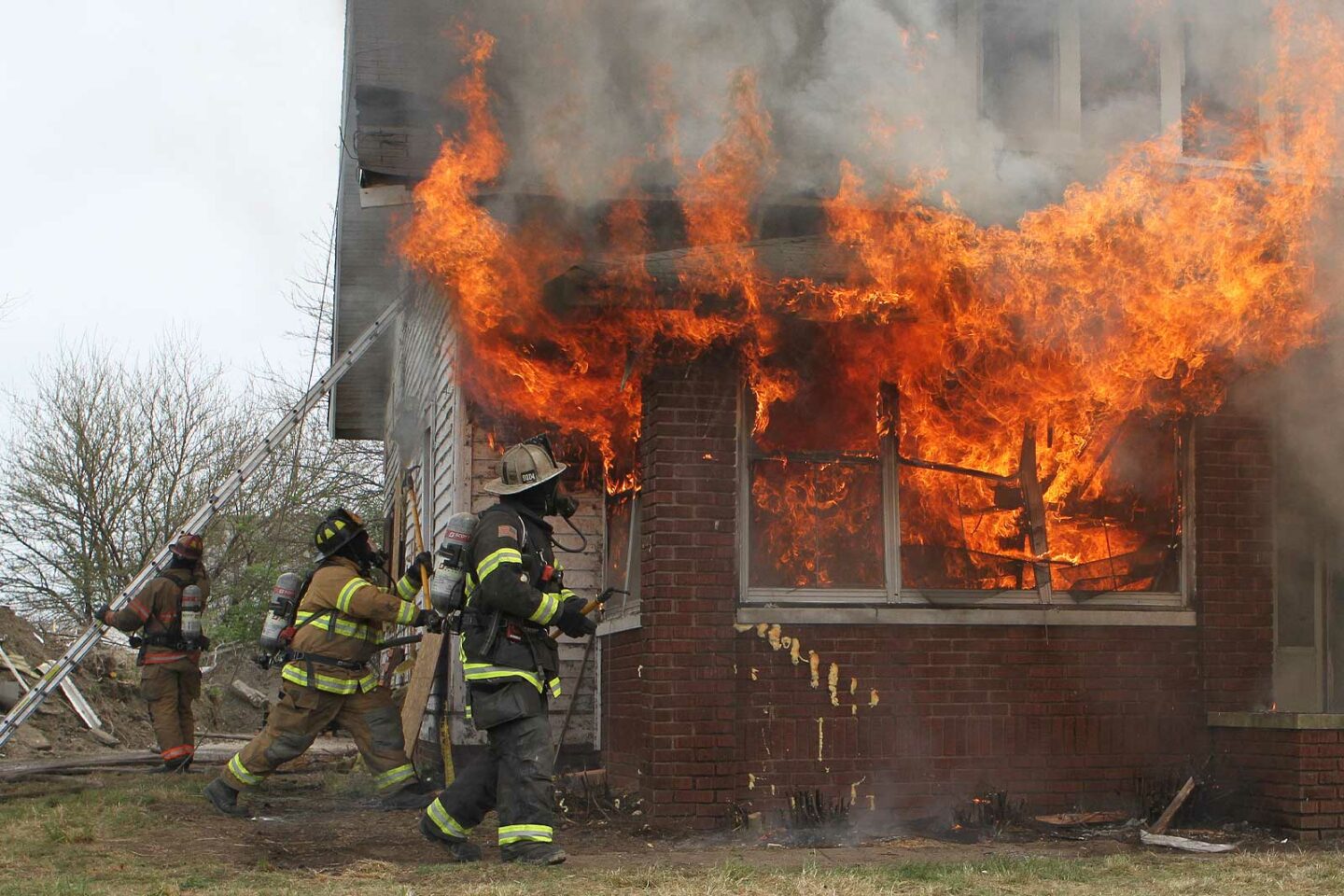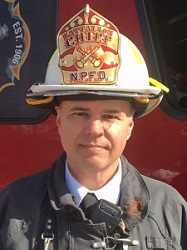
The alarm was transmitted just after 3:00 am. The firefighters of Engine 1 hastened to turn-out to the apparatus floor as the dispatcher announced the report of a house fire at 456 Oak Street. The two firefighters and their captain began preparing for what they may encounter upon arrival at the address, which was only a two-minute drive along the nearly empty streets of their district.
With his firefighters in the apparatus, the captain climbed to his seat, secured his seat belt, and acknowledged their response on the mobile data terminal while confirming the address with the vocal dispatch. Although the driver/operator was familiar with the district, the captain confirmed with him the route they would take to the call. The crew of Engine 1 knew that they would be first arriving with the second-in engine and first-in truck arriving form the headquarters station along with their battalion chief. The members of Engine 1 could expect reinforcements about four or five minutes after their arrival.
RELATED TRAINING
Fireground Pump Operations: Mastering the Panel
“Hitting the Hydrant” to Establish a Water Supply
As the rig made the last turn on to Oak Street, the firefighters could now see a distinct glow at the end of the block. The orange light of the leaping flames outshone the streetlights, and as the engine drew closer to the fire the street was cast with long shadows as nearby residents gathered on the sidewalk. The captain and his crew knew that in this neighborhood the residences were typically small, multi-unit dwellings built close to the street with very close exposures on either side.
With a large volume of fire visible from the end of the street, the captain ordered the driver/operator to stop at a hydrant located about 300 feet from the fire building. Although the second-arriving engine would ordinarily lay a supply line to the attack pumper, the captain of Engine 1 had formulated a strategy that would allow for an efficient and effective attack that could be easily supported by the next-arriving engine company. With his knowledge of the district, the captain was aware that, given the volume of fire he could already see, there would likely be severely threatened exposures and thus a need for a high-flow, rapid attack. The firefighter in the crew cab quickly dismounted and wrapped the five-inch supply line around the hydrant as the captain radioed his plans to the responding battalion chief and second-due engine.
The driver/operator proceeded slowly past the front of the fire building, leaving room for the truck company to position while allowing the master stream appliance above the pump panel an angle of attack on the visible fire. As the crew suspected, a large volume of fire was located on the second-floor front porch of a three-story tenement house. The fire had begun to extend to the third-floor porch and would soon make its way into the attic space through the eaves. The firefighter at the hydrant was making the connection as the captain began his 360° size-up, and the driver/operator made her way topside to position the master stream for action.
As the captain completed his survey and made his initial report of conditions, actions, and needs, he could hear the wail of sirens in the distance. The driver/operator charged the master stream and called for water from the hydrant. Upon securing the continuous water supply provided by the five-inch hose, the driver/operator returned to her position atop the apparatus to play the stream for optimal effectiveness.
RELATED TRAINING
Time Well Spent in the District
Overcoming an Insufficient Water Supply
The Basics of Enhancing Your Size-Up
The hydrant firefighter now made his way to the hosebed of the engine and began to stretch the appropriate length 1 ¾-inch line with the captain’s assistance. Based on his size-up survey and knowledge of the common buildings in the district, the captain knew an interior attack could be made to the fire floor via a door on the Delta side of the building. As the attack hose ran from the bed, the ladder company pulled up behind Engine 1 and the battalion chief could be heard over the radio announcing his arrival and assumption of command. The captain looked up at the front porch and observed that the bulk of the exterior fire had been darkened thanks to the large flow of the master stream. He signaled to the driver/operator to return to the pump panel and shut down the appliance. Upon this action, Engine 1 could begin to mount their interior attack with the support of the ladder company and second-arriving engine. With the exposure hazard and rapid interior fire spread efficiently in check to protect occupants and firefighters, a well-supported search-and-extinguishment operation was undertaken.
Lessons Reinforced
Arriving at 3:00 am with substantial exterior fire involving an occupied multi-family dwelling is a challenge for a single engine company. However, the crew of Engine 1 leveraged several factors to support the greatest possible use of their limited resources during the critical first minutes on the scene.
1. Know the District
There are numerous points to leverage when an officer and crew have a great deal of institutional knowledge about characteristics in their response area. In the case of Engine 1’s fire, this crew was familiar with hydrant locations and distances as well as the prevalent types of construction in this neighborhood, and perhaps even common types of fires in these buildings. The tenement houses in this neighborhood may suffer numerous outside fires on the front porches overnight because of carelessly discarded smoking materials. The large volume of fire close to the street that the captain noted from a distance offered an initial size-up clue. The members knew that there would be an exposure problem with neighboring tenements. Tactics to address these concerns were included in the captain’s initial actions.
The 360° size-up conducted by the officer helped to gain a better understanding of the situation and confirm certain aspects of the building layout. Not only could the captain make a better judgement about the extent of fire spread, but he was able to confirm the location of the door leading to all floors commonly found on the side or rear these occupancies. With this information, he was able to accurately determine the length of stretch an order the firefighter to use the correct length preconnect.
2. Make a Tactical Decision
When in charge, take charge. During this incident, the captain of Engine 1 was the first arriving incident commander. He sized up the situation and made tactical decisions based what he could realistically accomplish with his resources. He decided to put the most water possible on the fire to protect lives and lessen the chance of extension to internal or external. He was confident in his crew’s ability to accomplish their tasks. He knew the approximate response time for the next-arriving resources and he chose an option that allowed rapid application of water and establishment of a sustained water supply. Further, he communicated the deviation from the standard policy in which the second-arriving engine laid the supply line to the attack pumper. He advised the incoming battalion chief who would assume command of his initial actions so that the chief could be better prepared to support the operation upon his arrival.
3. High-Flow Attack Option
At this fire, the captain of Engine 1 chose to deploy the apparatus mounted master stream because it was the quickest option to put a large volume of water on the fire. The driver/ operator was able to position the apparatus in such a way that the stream was effective, yet the rig did not block out positioning for the first-arriving ladder company. Had the tenement featured rear-facing porches with the same fire, the captain may have opted to stretch a 2 ½-inch line or portable master stream. This would not have been as quick but may have still been the best initial tactic to combat the large volume of rapidly spreading fire. In any scenario, the decision to bring adequate water to the location of the fire as quickly as possible is the best way to save lives.
4. The Officer’s 360° Size-up
With the rapidly developing situation and limited initial resources, some officers may make the error of abandoning the size-up process and supporting the first tactical option they can see from the front seat of the rig. This can be a fatal error for the success of the operation as well as the lives of civilians and firefighters. After conducting the 360° size-up, the caption of Engine 1 was able to better visualize the extent of the fire spread on the second-floor porch and extension to the third-floor porch. He also confirmed that the fire had not yet traveled into the eaves, but that would happen soon without quick application of water. During the 360 size-up, the officer noted that no external exposure had become involved and that there were no victims at the windows awaiting rescue. He also confirmed that his avenue of internal attack would be undertaken through the door on the Delta side of the building once the master stream was shut down. The captain made the best use of a short period of time to gather as much additional information as possible to help guide and confirm his tactical decisions.
5. Know Your Capabilities
The captain of Engine 1 was able to order the tactics employed at this fire because he was confident that his company had the skill to carry out the tasks safely and efficiently. The only way to know how much your company can achieve is through training. Running scenario-based training with the company in a variety of suboptimal situations will expose areas where improvement may be needed and confirm your capabilities in situations like the fire described here. Company officers should be confident in the ability of their members to act decisively with minimal direct supervision: practice ways to leverage rapid high-flow fire attack, raise ladders with limited staffing, and ensure your driver/operators can secure their own water supply.
*
The key to successful fireground operations lies in the efficient and decisive actions of each company. The ability of first-arriving officers to rapidly assess the scene and set an initial action plan into motion will have a tremendous effect on incident outcome. The company officer can best be assured in his or her decision-making if they know their response area, know the capabilities of their members, and can leverage their resources with decisive commands.

David DeStefano is a battalion chief with the North Providence (RI) Fire Department, where he has served for 29 years. He is a shift commander in the operations division. He was previously chief of training and safety and has also served as a captain, lieutenant, and firefighter in Ladder Co. 1 as well as a lieutenant in Engine Co. 3. DeStefano is an instructor/coordinator with the Rhode Island Fire Academy and lectures on fire service topics throughout Southern New England. He was a presenter at FDIC International 2017 and 2018.

